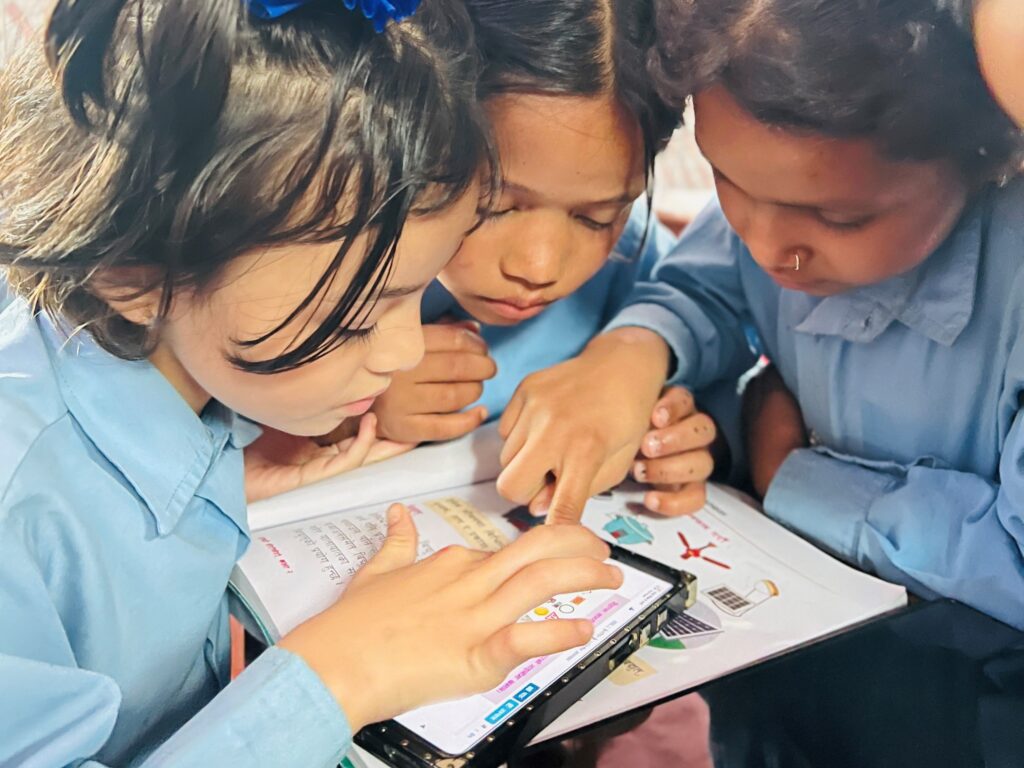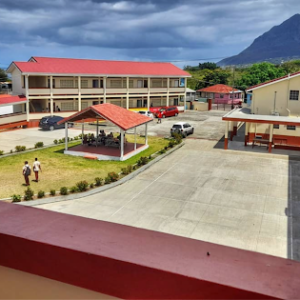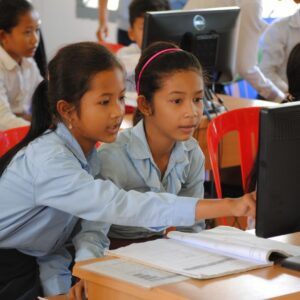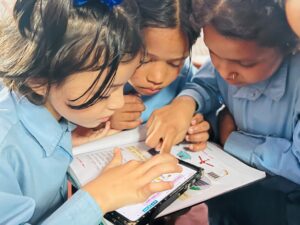
The recently released UNESCO Global Education Monitoring (GEM) Report, Technology in Education: A Tool on Whose Terms, asks if technology has really transformed education. Technology can increase opportunities for learners who have disabilities and expand access to teaching and learning resources, but only if teachers and students have reliable internet and devices and training.
It’s crucial that interventions ensure that technology serves education, not the other way around. We have to look at the costs and benefits and use technology intentionally to improve learning outcomes or other goals. At World Education, we envision a world in which all learners and teachers have access and skills to use digital tools that are designed and contextualized to meet their short and long-term needs. In addition to aligning with the Principles for Digital Development, our technology integration work is guided by these key approaches:
- Goals before Tools
- Locally Led and Community-Engaged
- Open Access
- Equitable and Inclusive Learning Opportunities
Goals before Tools
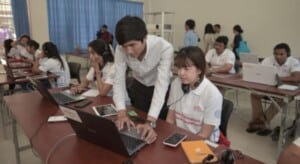
Defining goals for using technology in education is key to successful and sustainable outcomes. Our EdTech Center uses the phrase ‘goals before tools’ to signify the importance of planning how technology will support better outcomes. Frameworks for technology integration and digital skills are important for connecting use to goals, yet only about half of countries have defined the skills they want their citizens to develop or have standards for developing teachers’ information and communication technology (ICT) skills. (1)
In Cambodia, the Ministry of Education, Youth, and Sports (MoEYS) developed a policy and strategy for ICT and made digital education a priority, with a goal of equipping teachers and young people with the skills they need for the 21st century workforce.
As a result of prioritizing digital learning, we have been able to work with the MoEYS to develop digital formative and summative reading assessment tools, digitize the teacher mentoring system, and create a digital textbook ordering and tracking system. We’ve also developed a student early grade reading app, a digital high school equivalency program, and an online platform for educators’ continuous professional development.
We align with ministry priorities and policies while developing systems and platforms and integrating EdTech from the central to school level. We also consider and work to overcome challenges, like gaps in digital literacy and internet and device access, to meeting identified needs. The capacity for adopting technology must be assessed before an EdTech solution can be selected. With goal setting and proper preparation, EdTech interventions help individuals build their digital skills, increasing access, collaboration, and efficiency throughout the education system.
Locally Led and Community-Engaged
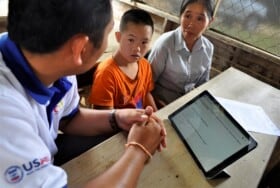
Before using technology to help meet a defined goal, it’s important to ascertain that the proposed application is “appropriate, equitable, evidence-based, and sustainable.” (2) Involving local communities in co-creation, scaling, and evaluation of interventions helps ensure that their needs are met.
In Laos, the USAID OKARD project team demonstrated how to integrate community input and local ownership into the development of a digital tool. The tool, a case management application, is modeled after a community-based inclusive development process to improve and sustain people with disabilities’ well-being and ability to live independently. It was co-designed with the Nossal Institute of Global Health and University of Melbourne in close collaboration with organizations of people with disabilities (OPD) and community workers from local civil society organizations.
Adoption of technology relies on buy-in from all affected parties. OPD and community workers were essential for contextualizing the tool to the local environment so it provides a comprehensive understanding of unmet needs. The project team conducted cognitive testing with people with disabilities and their families. Government partners provided input on how the data collected supported system strengthening for health and social protection. This input and feedback was used to refine the tool.
Collaboration and a shared vision are necessary for technology to be useful. In this case, the digital case management tool is reducing time and errors in data collection and strengthening data sharing and analysis. More reliable data help people with disabilities advocate for their rights and inform appropriate services.
Open Access
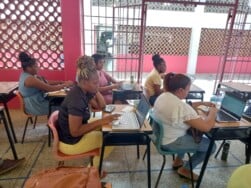
Digital technology has increased access to teaching and learning resources and facilitated the creation and sharing of open educational resources (OERs). Of these online resource repositories, though, almost 90 percent were created in Europe or North America, and 92 percent of the material in the OER Commons global library is in English. (3)
Service-learning professional development opportunities (like our EdTech Maker Space events) allow teachers to build digital skills and locate and develop online resources that fit their classroom and their learners’ needs. Using this model in different contexts builds digital skills and increases the diversity of OERs, which we have seen in Saint Lucia through the ConnectEd Activity.
We found that prior to ConnectEd, educators had limited knowledge of which digital skills to teach, and which resources were available, and how to integrate them into their teaching routine in a way that engaged and was relevant to students’ lives. As they participated in professional development opportunities through ConnectEd and learned more about online learning resources, they started to see how digital tools could fit into their classrooms. If they planned its use and ensured students clearly understood how technology was helping them learn, it could succeed.
To align online learning content to Saint Lucian culture and context, teachers and students are creating their own resources. Through this co-creation process, they gain personal and professional knowledge and help others do the same. The ongoing creation of digital OERs adds value to the overall educational landscape of Saint Lucia, extending learning beyond classroom walls. We’re working with the government to continue the EdTech Maker Space process, develop more resources, and continue to organize them in a central hub.
Equitable and Inclusive Digital Learning Opportunities
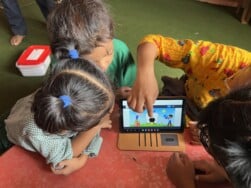
Digital technologies can also lower barriers to education for some, including people who live in remote areas, are displaced, face learning difficulties, and have interrupted formal education. Technology diversifies the presentation of, representation in, and engagement with information. The GEM report stresses the importance of following Universal Design for Learning (UDL) principles to ensure that products, services, and environments are usable by all people to the greatest extent possible without the need for adaptation or specialized design. (4)
The Leveraging Existing Accessibility Resources in Nepal (LEARN) project, funded through the UnrestrICTed Challenge of All Children Reading: A Grand Challenge for Development, a partnership between USAID, World Vision, and the Australian Government, is applying UDL principles while integrating low and high-tech materials into schools. These include decodable books, TV screens and tablets, and Nepali Sign Language resources. Blending low- and high-tech resources helps meet individual student needs and learning styles and increases participation. While there are challenges to using technology, it makes learning more accessible by allowing teachers to find resources, such as audio materials for students who are deaf.
An EdTech Toolkit that the project developed hosts a centralized collection of resources organized for easy access. It includes over 500 books in 10 local languages and a section for disability-focused materials. In addition to resources for students, there are materials for teachers to use in the classroom and parental engagement materials, like radio messages in local languages. The toolkit is open access and freely available for public use.
Conclusion
Is technology transforming education? We think it can if it is used intentionally; if we set goals and co-create materials and approaches with local leadership, support diverse learning needs, and build capacity to develop and apply technology in each context. These approaches let us focus on learning, stay connected to community needs, and remain flexible and adaptive as the rapid pace of technological change demands.
There’s still a need to measure the effect of technology in education and adapt to evolving platforms, like artificial intelligence (AI). Right now, only 11 of 51 governments surveyed have curricula for AI. We’re holding discussions on the impact of AI on education and ways we can use it to increase access to learning for all.
______________________________________________________________________________________
(1) Page 4 in GEM report.
(2) Page 24 in GEM report.
(3) Page 45 in GEM report.
(4) Page 35 in GEM report.

